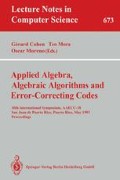Abstract
A group algebra code is an ideal in a group ring, FG. If char(F) χ order(G), then FG is semi-simple and every such code has an idempotent generator. The group ring and every group algebra code in it are direct sums of disjoint minimal ideals. Thus a list of all possible codes in FG may be produced by first determining idempotent generators of minimal codes which are direct summands of FG. When G is abelian, the task is straightforward and is facilitated by use of the character table for G. When G is non-abelian, however, two-sided ideals, which correspond to the group characters of G, in FG may decompose in multiple ways to one-sided ideals. The decomposition may be varied by altering the matrix representations afforded by the group representations. The number of ways the representation may be altered is limited by the structure of the representation space. With sufficient information about this space, all possible decompositions can be determined. A case study is presented in which a (125,20) two-sided ideal is found to contain 162 disjoint minimal left ideals, each with a distinct weight distribution.
Preview
Unable to display preview. Download preview PDF.
References
Camion, P., “Abelian Codes,” MRC Tech. Sum. Rep. #1059, University of Wisconsin, Madison, Wis (1971).
Cheng, Ying, N. J. A. Sloane, “Codes from Symmetry Groups, and a [32,17,8] Code,” SIAM J. Disc. Math., 2 (1989), pp. 28–37.
Curtis, Charles W., Irving Reiner, Representation Theory of Finite Groups and Associative Algebras, Interscience Publishers, New York (1962).
Hall, Marshall, Jr., The Theory of Groups, The Macmillan Co., New York (1959).
Keown, R., An Introduction to Group Representation Theory, Academic Press, New York (1975).
MacWilliams, F. J., N. J. A. Sloane, The Theory of Error-Correcting Codes, North-Holland, New York (1977).
Nagao, Hirosi, Yukio Tsushima, Representations of Finite Groups, Academic Press, New York (1987).
Sabin, Roberta Evans, “Metacyclic Error-Correcting Codes,” PhD dissertation, University of Maryland, Baltimore (1990).
Sabin, Roberta Evans, “On Row-Cyclic Codes with Algebraic Structure” (in preparation).
Serre, J.-P., Linear Representations of Finite Groups, Graduate Text in Math., 42, Springer-Verlag, New York (1977).
Author information
Authors and Affiliations
Editor information
Rights and permissions
Copyright information
© 1993 Springer-Verlag Berlin Heidelberg
About this paper
Cite this paper
Sabin, R.E. (1993). On determining all codes in semi-simple group rings. In: Cohen, G., Mora, T., Moreno, O. (eds) Applied Algebra, Algebraic Algorithms and Error-Correcting Codes. AAECC 1993. Lecture Notes in Computer Science, vol 673. Springer, Berlin, Heidelberg. https://doi.org/10.1007/3-540-56686-4_50
Download citation
DOI: https://doi.org/10.1007/3-540-56686-4_50
Published:
Publisher Name: Springer, Berlin, Heidelberg
Print ISBN: 978-3-540-56686-1
Online ISBN: 978-3-540-47630-6
eBook Packages: Springer Book Archive

